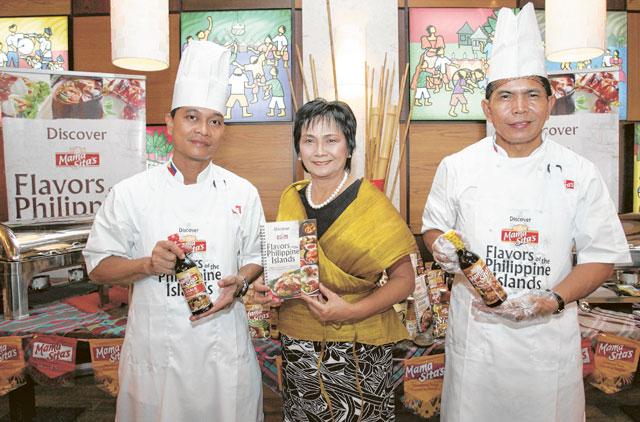Dubai: The grande dame of Filipino cuisine is making a bigger play for a larger serving of the UAE's ethnic foods marketplace.
The way Teresita "Mama Sita" Reyes intends to go about it is by transplanting the cult following she and her "Mama Sita's" brand enjoy back home to within the substantial Filipino community here.
Already, seven containers of Mama Sita products are shipped in each month through an exclusive distribution agreement with Dubai-based Shankar Trading Co and the Mama Sita's range is finding its way to supermarket shelves, specialty food stores and food and beverage outlets patronised by Filipino customers in the UAE.
Now, the brand's sights are set even higher.
The intention is nothing less than to "get more market share from other nationalities".
"It is a growing market and we are looking to tap into food handlers such as hotels, restaurants and caterers," said Clara Reyes Lapus, daughter of Teresita Reyes and president of the Mama Sita's Foundation, while in Dubai last week.
The Mama Sita's range also find its way to the US, Europe, the rest of south-east Asia and even other markets within this region, such as Egypt and Yemen.
Instant bestsellers
For expatriate Filipinos, these sauces and mixes help solve the problem of trying to locate hard-to-find ingredients for authentic Filipino dishes.
"Because wherever you are, you always want a taste of home," said Lapus.
Two products have been instant bestsellers — the Tamarind Seasoning Mix and Oyster Sauce, according to feedback from Shankar Trading Co.
Now, the brand is finding common cause with the organic food movement.
"They are healthier to use because there are no toxic additives and all the ingredients are homegrown by our farmers," said Lapus.
She said further that a recent addition to the product line is an all-natural coconut nectar vinegar. Others include the three-MPCD-free sauce made from real oysters, anatoxin-free peanut based sauces, and a non-artificial food colouring annatto powder.
"I want to pass on all-natural products to others," Lapus added, though she did say that they come at a higher retail price.
Another mission
"But would you rather pay more for a natural product or use cheap products with less health benefits?" she asked. Lapus had another mission to accomplish during her Dubai visit.
This had to do with the launch of the Mama Sita's cookbook, featuring time-tested and contemporary Filipino dishes "made easy for home cooks in the Middle East". The book Discover Flavors of the Philippine Islands also has an underlying message — of how the many Mama Sita's mixes and sauces can be used in cooking all the dishes mentioned in the tome.
It is a compilation of recipes from Teresita Reyes, who ran a chain of restaurants in the Philippines and pioneered the production of the first Filipino line of seasoning mixes in the early 1970s.
"It is our way of bringing Philippines cuisine to global attention," Lapus said. Now, bring on the sauces!
Flavours of land and sea
Think Betty Crocker and one will have an idea of the standing that Mama Sita's seasoning sauces and mixes have among Filipino gourmands.
Teresita - "Mama Sita" - Reyes came from a family of eleven whose love for food and cooking are the stuff of culinary legends in the Philippines. She was the eldest daughter of Doña Engracia — "Aling Asiang" — Reyes, herself regarded as a pioneer in the country's F&B industry and promoter of a chain of restaurants.
For a country that is shaped by as many as 7,000 islands and more, Filipino cuisine can be quite varied. So, in northern Luzon, where the landscape is mostly made up of mountain ranges, the cuisine mostly features stews consisting of vegetables that can be easily grown in the backyards of homes.
The provinces of Bulacan and Pampanga, located on river deltas and fertile plains, have more exotic dishes such as "relleno", "estofado" and "asado". The fields there also yield an abundant harvest of grains, providing an endless selection of rice cakes and rice entrees like "bringhe" and "paella".
With their proximity to water bodies, the southern Tagalog provinces of Batangas, Laguna, Quezon, Cavite and Rizal have developed a cuisine that resonates with the flavours of the land and sea.
In the Bicol peninsula, where typhoons are de riguer, residents have perfected the use of sili (chili) to concoct a cuisine that is fiery hot. The abundance of coconuts has also enhanced the regional cuisine.
The islands of the Visayas — whose reefs teem with fish and whose lands are some of the most arable in the country — are home to some of the purest flavours, especially of seafood. In Dumaguete, freshly caught dilis (anchovy) is gutted and marinated in vinegar, lime juice and sili and cream of grated coconut to create "kinilaw". In Bacolod, inasal, or grilling is the favoured method of cooking poultry.
Mindanao is home to flora and fauna. Spices such as turmeric, lemongrass and cilantro are used extensively. Here, tables are laden with harvests such as durian, mangosteen and marang.













